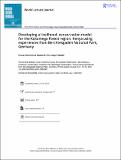| dc.contributor.author | Oscar Kambona Ouma, Christoph Stadel | |
| dc.date.accessioned | 2021-07-19T07:11:06Z | |
| dc.date.available | 2021-07-19T07:11:06Z | |
| dc.date.issued | 2021 | |
| dc.identifier.uri | https://repository.maseno.ac.ke/handle/123456789/4181 | |
| dc.description.abstract | Active participation of local community of Kakamega Forest in conservation has rather been elusive. Conservation efforts directed at the Forest have resulted into more resource use restrictions instead of access. Furthermore, the community faces the threat of human-wildlife conflict. Achieving a resilient livelihood and active forest conservation among the Community has therefore been a challenge. Against this background, the study sought to develop a conservation model for the Kakamega Forest region using experiences from Berchtesgaden National Park, Germany. The study adopted emic and etic approaches. A variety of interview methods were used to gain the inside feelings of the respondents with regard to livelihoods and conservation experiences. The resulting data were identified, coded and patterns reported using thematic analysis. Results indicated that most of the livelihood strategies being used by the local community of Kakamega forest are small scale and have a weak link to tourism and conservation activities. On the contrary, results from Berchtesgaden National Park indicated a livelihood asset base which is strong, diversified and strongly linked to tourism. The model developed gives more understanding and insight into the often delicate balance between livelihoods and conservation. | en_US |
| dc.publisher | Routledge | en_US |
| dc.subject | Livelihoods,sustainability,conservation,model,Kakamega forest,Berchtes gaden national park | en_US |
| dc.title | Developing a livelihood: conservation model for the Kakamega Forest region, Kenya using experiences from Berchtesgaden National Park, Germany | en_US |
| dc.type | Article | en_US |

